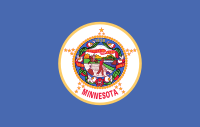Portal:Minnesota
The Minnesota Portal Minnesota (/ˌmɪnəˈsoʊtə/ ⓘ MIN-ə-SOH-tə) is a state in the Upper Midwestern region of the United States. It is the 12th largest U.S. state in area and the 22nd most populous, with over 5.75 million residents. Minnesota is known as the "Land of 10,000 Lakes" for having more than 14,000 bodies of fresh water covering at least ten acres each; roughly a third of the state is forested; much of the remainder is prairie and farmland. More than 60% of Minnesotans (about 3.7 million) live in the Minneapolis–Saint Paul metropolitan area, known as the "Twin Cities", the state's main political, economic, and cultural hub and the 16th-largest metropolitan area in the U.S. Other minor metropolitan and micropolitan statistical areas include Duluth, Mankato, Moorhead, Rochester, and St. Cloud. Minnesota, which gets its name from the Dakota language, has been inhabited by various Indigenous peoples since the Woodland period of the 11th century BCE. Between roughly 200 and 500 CE, two areas of the indigenous Hopewell tradition emerged: the Laurel complex in the north, and Trempealeau Hopewell in the Mississippi River Valley in the south. The Upper Mississippian culture, consisting of the Oneota people and other Siouan speakers, emerged around 1000 CE and lasted through the arrival of Europeans in the 17th century. French explorers and missionaries were the earliest Europeans to enter the region, encountering the Dakota, Ojibwe, and various Anishinaabe tribes. Much of what is now Minnesota formed part of the vast French holding of Louisiana, which the United States purchased in 1803. After several territorial reorganizations, the Minnesota Territory was admitted to the Union as the 32nd state in 1858. Minnesota's official motto, L'Étoile du Nord ("The Star of the North") is the only state motto in French; this phrase was adopted shortly after statehood and reflects both the state's early French explorers and its position as the northernmost state in the contiguous U.S. As part of the American frontier, Minnesota attracted settlers and homesteaders from across the country. Its growth was initially based on timber, agriculture, and railroad construction. Into the early 20th century, European immigrants arrived in significant numbers, particularly from Scandinavia, Germany, and Central Europe; many were linked to the failed revolutions of 1848, which partly influenced the state's development as a center of labor and social activism. Minnesota's rapid industrialization and urbanization precipitated major social, economic, and political changes in the late 19th and early 20th centuries; the state was at the forefront of labor rights, women's suffrage, and political reform. Consequently, Minnesota is unique among Midwestern states in being a relative stronghold of the Democratic Party, having voted for every Democratic presidential nominee since 1976, longer than any other U.S. state. (Full article...) Entries here consist of Good and Featured articles, which meet a core set of high editorial standards.
 Louis Francois Menage (August 3, 1850 – March 18, 1924) was a real estate speculator and prominent figure in early Minneapolis, Minnesota history. Born in Rhode Island, he settled in Minneapolis in 1874. Characterized as a "tycoon" and "robber baron," Menage earned a fortune developing land on the city's borders into residential housing and financing the mortgages to enable people to buy his properties. During the 1870s and 1880s, he developed large areas of South Minneapolis including much of the area around Lake Calhoun and Lake Harriet. He also developed a luxury resort on Lake Calhoun and built a corporate headquarters which was at the time the city's tallest skyscraper. After a costly legal battle over a real estate deal with William S. King and the financial downturn of the Panic of 1893, Menage's real estate empire collapsed and he fled the country to avoid prosecution on charges of embezzlement. The charges against Menage were eventually dropped after several key witnesses had died or become hesitant to testify against him. He spent the later portion of his life working in real estate in the New York City area and never worked in Minnesota again. (Full article...)Selected article -Bloomington is a city in Hennepin County, Minnesota, United States, on the north bank of the Minnesota River, above its confluence with the Mississippi River, 10 miles (16 km) south of downtown Minneapolis. At the 2020 census, the city's population was 89,987, making it Minnesota's fourth-largest city. Bloomington was established as a post–World War II housing boom suburb connected to Minneapolis's urban street grid, and is serviced by four major freeways: Interstate 35W running north-south through the approximate middle of the city, Minnesota State Highway 77, also signed as Cedar Avenue, running north-south near the eastern end of the city, U.S. Highway 169, running north-south along the western boundary of the city, and Interstate 494 running east-west at the northern border. Minnesota State Highway 100 also terminates just north of city limits at Interstate 494. Large-scale commercial development is concentrated along the I-494 corridor. Besides an extensive city park system, with over 1,000 square feet (93 m2) of parkland per capita, Bloomington is also home to Hyland Lake Park Reserve in the west and Minnesota Valley National Wildlife Refuge in the southeast. (Full article...)General images -The following are images from various Minnesota-related articles on Wikipedia.
Did you know -
Related portalsTopicsLargest cities
CategoriesNew articlesThis list was generated from these rules. Questions and feedback are always welcome! The search is being run daily with the most recent ~14 days of results. Note: Some articles may not be relevant to this project.
Rules | Match log | Results page (for watching) | Last updated: 2024-04-27 21:03 (UTC) Note: The list display can now be customized by each user. See List display personalization for details.
WikiProjectsTasks
Associated WikimediaThe following Wikimedia Foundation sister projects provide more on this subject:
Sources
Discover Wikipedia using portals |















































